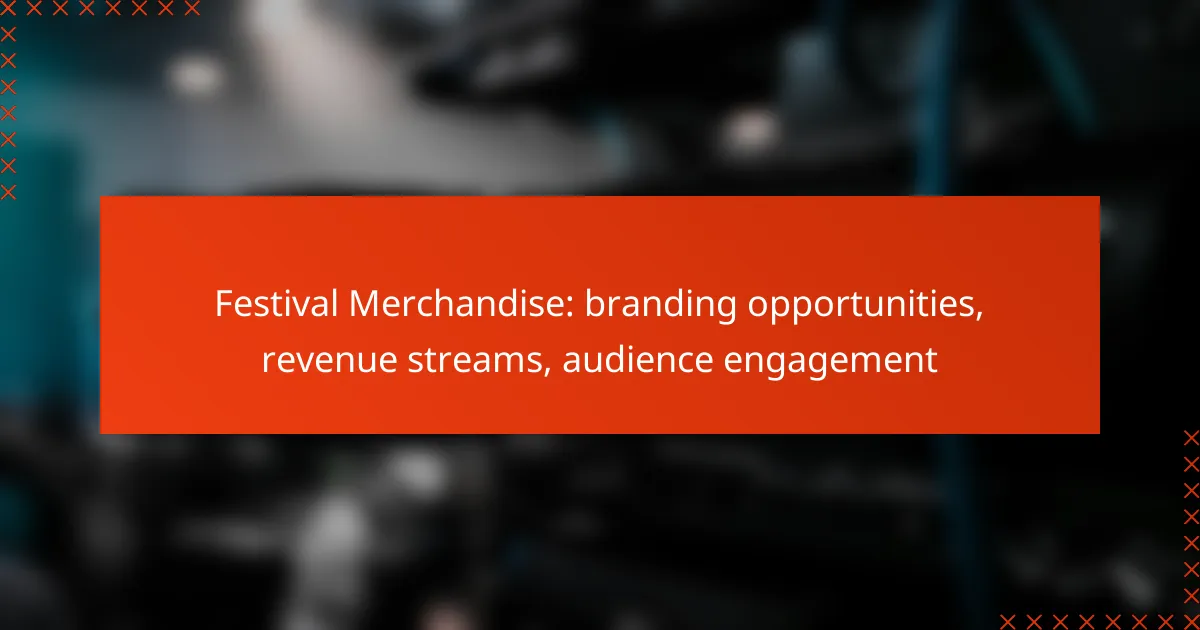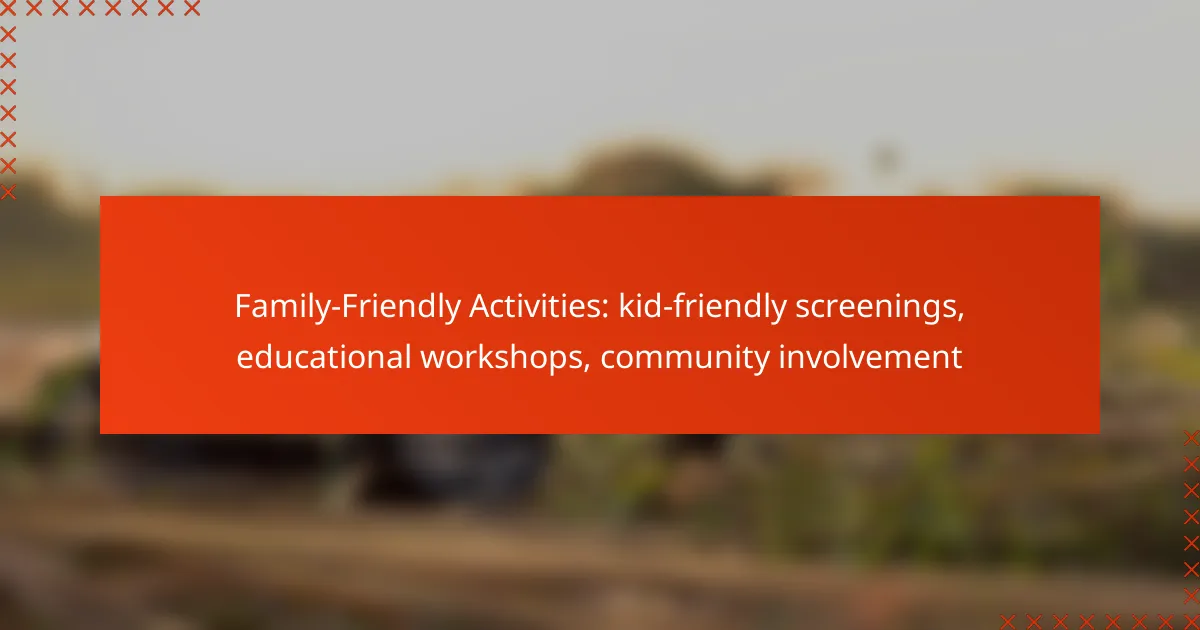Festival merchandise serves as a powerful tool for enhancing brand identity and creating memorable experiences for attendees. By offering unique products, festivals can tap into various revenue streams while fostering deeper connections with their audience, ultimately driving engagement and loyalty. This strategic approach not only boosts profitability but also solidifies the emotional ties between fans and the event brand.

How can festival merchandise enhance branding opportunities in Australia?
Festival merchandise can significantly enhance branding opportunities in Australia by creating a tangible connection between the event and its audience. Unique products not only promote brand identity but also generate additional revenue streams while engaging attendees in a memorable way.
Unique designs for brand identity
Unique merchandise designs play a crucial role in establishing a festival’s brand identity. By incorporating distinctive logos, colors, and themes, festivals can create products that resonate with their target audience. This visual representation helps solidify the brand in the minds of attendees, making it more recognizable and memorable.
Consider offering limited edition items that reflect the festival’s theme or ethos. This exclusivity can drive demand and encourage attendees to showcase their purchases, further promoting the brand.
Collaborations with local artists
Collaborating with local artists can enhance the appeal of festival merchandise while supporting the community. These partnerships can lead to unique, culturally relevant designs that resonate with festival-goers. Local artists bring their own fan base, which can expand the festival’s reach and visibility.
For example, a music festival might feature merchandise designed by local musicians or visual artists, creating a sense of authenticity and connection to the local culture. This strategy not only boosts sales but also fosters a sense of pride among attendees.
Customizable merchandise options
Offering customizable merchandise options allows festival-goers to personalize their purchases, increasing their emotional connection to the brand. Options could include custom prints, colors, or even the ability to add names or messages. This level of personalization can lead to higher sales and customer satisfaction.
Consider setting up on-site stations where attendees can customize items like t-shirts or bags. This interactive experience not only enhances engagement but also creates lasting memories associated with the festival.
Brand storytelling through products
Merchandise can serve as a storytelling medium for the festival brand. Each product can convey a narrative about the festival’s mission, values, or history. This storytelling aspect can deepen the emotional connection between the brand and its audience.
For instance, using eco-friendly materials for merchandise can communicate a commitment to sustainability, appealing to environmentally conscious attendees. Clear messaging on product tags or packaging can reinforce this narrative and enhance brand loyalty.
Utilizing social media for promotion
Social media is a powerful tool for promoting festival merchandise and enhancing brand visibility. By showcasing products through engaging content, festivals can reach a wider audience and encourage pre-event purchases. Platforms like Instagram and Facebook are ideal for sharing high-quality images and videos of merchandise.
Encourage attendees to share their merchandise on social media using a specific hashtag. This user-generated content can create buzz and excitement, driving further interest in the festival and its offerings. Consider running contests or giveaways to incentivize sharing and increase engagement.
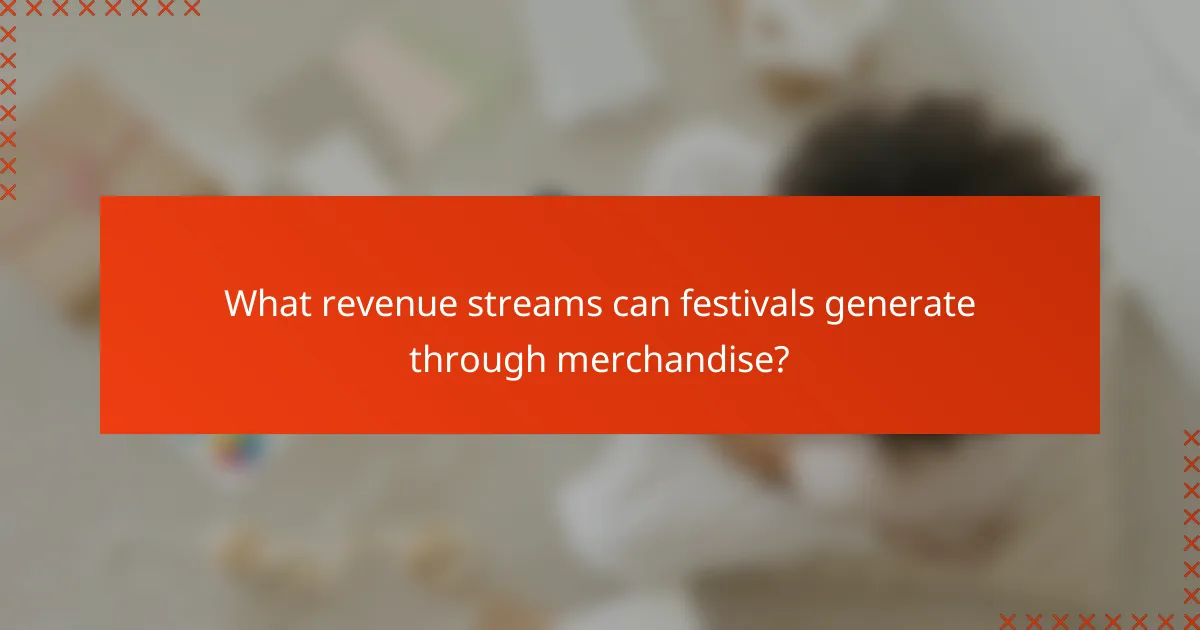
What revenue streams can festivals generate through merchandise?
Festivals can generate substantial revenue through various merchandise streams, including direct sales at events, online stores, partnerships, and licensing deals. These avenues not only enhance profitability but also strengthen brand engagement with attendees.
Direct sales at events
Direct sales at events involve selling merchandise on-site during the festival. This can include apparel, accessories, and memorabilia that resonate with the festival’s theme. Offering exclusive items can drive higher sales, as attendees often seek unique products that capture their experience.
To maximize revenue, consider setting up multiple sales points and using mobile payment options to streamline transactions. Pricing should reflect both the quality of the merchandise and the perceived value among attendees.
Online merchandise stores
Online merchandise stores provide a platform for festivals to sell products year-round, extending revenue beyond the event dates. This approach allows fans who couldn’t attend to purchase items, increasing overall sales potential.
When setting up an online store, ensure it is user-friendly and mobile-optimized. Promote the store through social media and email marketing to reach a wider audience. Offering limited-time promotions can create urgency and boost sales.
Partnerships with local businesses
Partnering with local businesses can enhance merchandise offerings and create additional revenue streams. Collaborations with local artisans or shops can lead to unique products that reflect the community’s culture and attract more attendees.
Consider co-branding opportunities where both the festival and the local business benefit. This can include shared marketing efforts and cross-promotions, which can enhance visibility and sales for both parties.
Licensing deals for branded products
Licensing deals for branded products allow festivals to expand their merchandise offerings without the need for upfront production costs. By partnering with established brands, festivals can create co-branded items that appeal to a broader audience.
When negotiating licensing agreements, focus on terms that ensure quality and brand alignment. This approach can lead to increased revenue while maintaining the festival’s integrity and reputation.

How does audience engagement impact merchandise sales?
Audience engagement significantly boosts merchandise sales by creating a deeper connection between fans and products. Engaged audiences are more likely to purchase items that resonate with their experiences and emotions linked to the event or brand.
Interactive merchandise experiences
Interactive merchandise experiences allow fans to engage directly with products, enhancing their emotional connection. For example, pop-up shops at festivals where attendees can customize items, such as T-shirts or hats, can drive higher sales. These experiences not only increase immediate purchases but also create memorable moments that fans share with others.
Feedback loops for product improvement
Establishing feedback loops enables brands to gather insights from their audience about merchandise preferences. Surveys, social media polls, and direct conversations can reveal what fans want, allowing for timely adjustments to product offerings. Implementing this feedback can lead to increased satisfaction and repeat purchases.
Exclusive merchandise for loyal fans
Offering exclusive merchandise to loyal fans can significantly enhance engagement and drive sales. Limited edition items, such as festival-specific gear or collaborations with popular artists, create a sense of urgency and exclusivity. This strategy not only rewards loyal supporters but also encourages new fans to engage more deeply with the brand.
Engagement through social media campaigns
Social media campaigns are a powerful tool for driving audience engagement and merchandise sales. By creating shareable content, such as contests or behind-the-scenes looks at merchandise production, brands can encourage fans to participate and spread the word. Utilizing platforms like Instagram or TikTok can amplify reach and create buzz around new product launches.
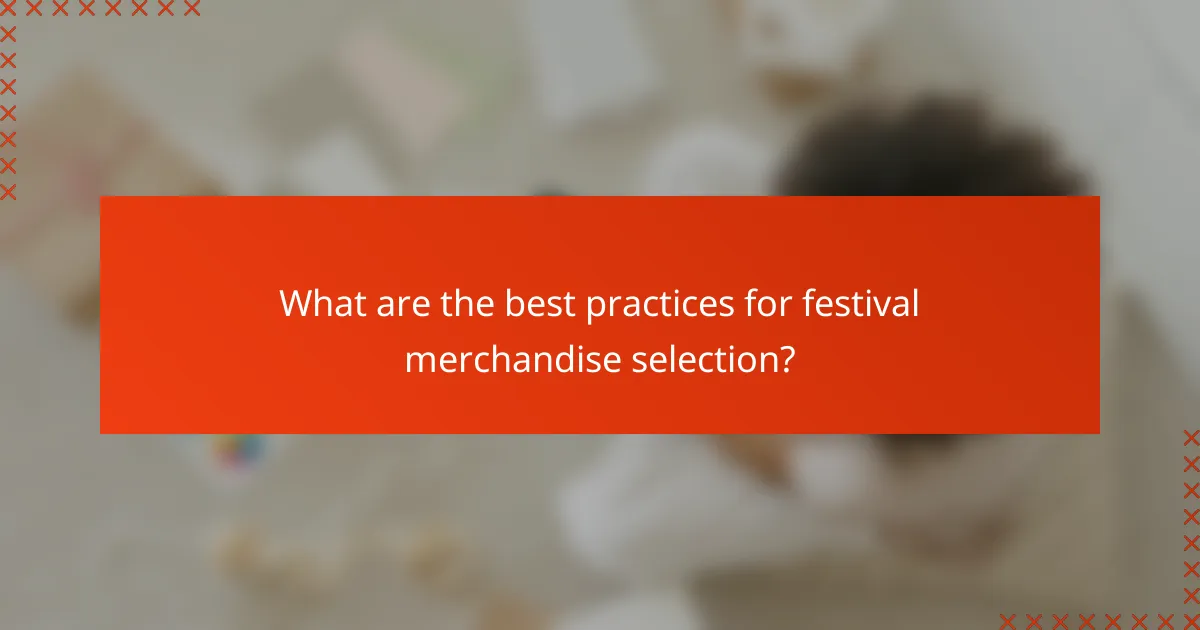
What are the best practices for festival merchandise selection?
Selecting the right festival merchandise involves understanding your audience, choosing sustainable materials, and implementing effective pricing strategies. These practices not only enhance brand visibility but also create additional revenue streams and foster audience engagement.
Understanding target audience preferences
Identifying the preferences of your target audience is crucial for successful merchandise selection. Conduct surveys or analyze past sales data to determine what items resonate most with attendees, such as apparel, accessories, or unique collectibles.
Consider demographic factors like age, interests, and lifestyle when curating your merchandise. For example, younger audiences may prefer trendy items, while older attendees might appreciate classic designs or functional products.
Choosing sustainable materials
Opting for sustainable materials not only appeals to environmentally conscious consumers but also enhances your brand’s reputation. Materials like organic cotton, recycled polyester, and biodegradable packaging can significantly reduce your festival’s ecological footprint.
When selecting materials, ensure they align with your brand values and messaging. For instance, if your festival promotes eco-friendliness, using sustainable materials can reinforce that commitment and attract like-minded attendees.
Pricing strategies for different demographics
Implementing effective pricing strategies is essential to cater to various demographics at your festival. Consider tiered pricing to accommodate different budgets, offering a range of products from affordable items to premium merchandise.
Monitor competitor pricing and adjust your strategies accordingly. For example, if similar festivals charge around $20 for t-shirts, aim for a competitive price point while ensuring quality. Offering discounts for bulk purchases can also encourage higher sales volumes.
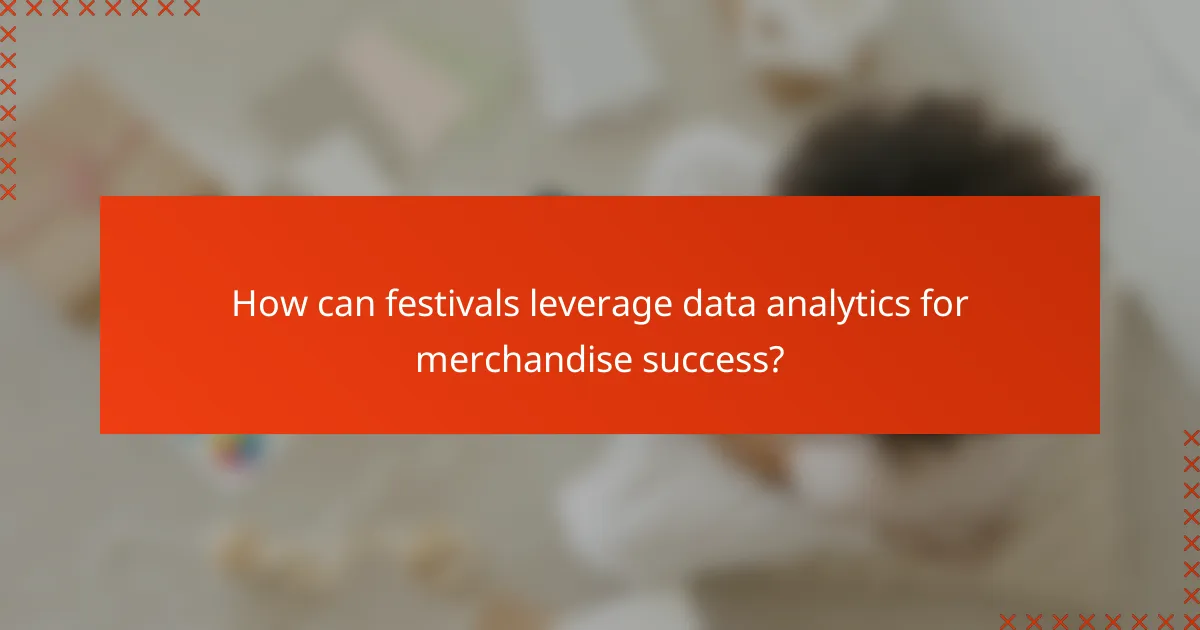
How can festivals leverage data analytics for merchandise success?
Festivals can enhance merchandise success by utilizing data analytics to understand customer preferences and optimize inventory. By analyzing sales data, festivals can identify trends, tailor offerings, and improve overall engagement with attendees.
Tracking sales trends
Tracking sales trends involves monitoring merchandise performance over time to identify what items are popular and when they sell best. This data can help festivals adjust their inventory and marketing strategies, ensuring that high-demand products are readily available.
For example, if a festival notices that certain t-shirts sell significantly better during the first day, they can increase stock for that item in future events. Additionally, analyzing sales by time of day can reveal peak purchasing hours, allowing for targeted promotions during those times.
Festivals should consider using point-of-sale systems that integrate with analytics tools to streamline data collection. Regularly reviewing sales reports can help identify patterns and inform decisions on future merchandise offerings.
